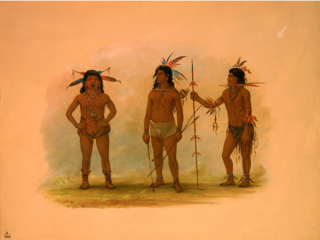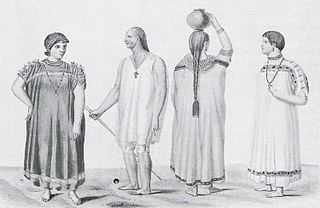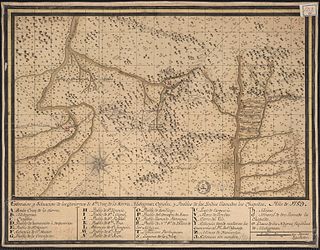
The Society of Jesus is a religious order of the Catholic Church headquartered in Rome. It was founded by Ignatius of Loyola with the approval of Pope Paul III in 1540. The members are called Jesuits. The society is engaged in evangelization and apostolic ministry in 112 nations. Jesuits work in education, research, and cultural pursuits. Jesuits also give retreats, minister in hospitals and parishes, sponsor direct social ministries, and promote ecumenical dialogue.

Guaraní are a group of culturally related indigenous peoples of South America. They are distinguished from the related Tupí by their use of the Guaraní language. The traditional range of the Guaraní people is in present-day Paraguay between the Uruguay River and lower Paraguay River, the Misiones Province of Argentina, southern Brazil once as far north as Rio de Janeiro, and parts of Uruguay and Bolivia. Although their demographic dominance of the region has been reduced by European colonisation and the commensurate rise of mestizos, there are contemporary Guaraní populations in these areas. Most notably, the Guaraní language, still widely spoken across traditional Guaraní homelands, is one of the two official languages in Paraguay, the other one being Spanish. The language was once looked down upon by the upper and middle classes, but it is now often regarded with pride and serves as a symbol of national distinctiveness. The Paraguayan population learns Guaraní both informally from social interaction and formally in public schools. In modern Spanish, Guaraní also refers to any Paraguayan national in the same way that the French are sometimes called Gauls.

The Jesuit reductions, better known as the Paraguayan reductions, were a type of settlement for indigenous people specifically in the Rio Grande do Sul area of Brazil, Paraguay and neighbouring Argentina in South America, established by the Jesuit Order early in the 17th century and wound up in the 18th century with the banning of the Jesuit order in several European countries. Subsequently it has been called an experiment in "socialist theocracy" or a rare example of "benign colonialism".

The Pima are a group of Native Americans living in an area consisting of what is now central and southern Arizona. The majority population of the surviving two bands of the Akimel Oʼodham are based in two reservations: the Keli Akimel Oʼotham on the Gila River Indian Community (GRIC) and the On'k Akimel Oʼodham on the Salt River Pima-Maricopa Indian Community (SRPMIC).

The suppression of the Jesuits in the Portuguese Empire (1759), France (1764), the Two Sicilies, Malta, Parma, the Spanish Empire (1767) and Austria and Hungary (1782) is a complex topic. Analysis of the reasons is complicated by the political maneuvering in each country which was not carried out in the open but has left some trail of evidence. The papacy reluctantly went along with the demands of the various Catholic kingdoms involved, and advanced no theological reason for the suppression.

Domenico Zipoli was an Italian Baroque composer who worked and died in Córdoba, in the Viceroyalty of Peru, Spanish Empire,. He became a Jesuit in order to work in the Reductions of Paraguay where he taught music among the Guaraní people. He is remembered as the most accomplished musician among Jesuit missionaries.

The Cambeba people are an indigenous people in Brazil's Amazon Basin. Their territory, when first in contact with Spanish explorers in the 16th century, was on the Amazon River upstream from the present-day city of Manaus extending into Peru. They speak the Omagua language. The Cambeba exist today in small numbers, but they were a populous, organized society in the late Pre-Columbian era. Their population suffered steep decline, mostly from infectious diseases, in the early years of the Columbian Exchange. During the eighteenth century, the Cambeba largely abandoned their indigenous identity in response to prejudice and racism that marginalized aboriginal peoples in Brazil and Peru. A more enlightened cultural attitude led to a renewed tribal identity starting in the 1980s.
The Opata are three indigenous peoples of Mexico. Opata territory, the “Opatería” in Spanish, encompasses the mountainous northeast and central part of the state of Sonora, extending to near the border with the United States. Most Opatan towns were situated in river valleys and had an economy based on irrigated agriculture. In the 16th century, when they first met the Spanish explorers, the Opata were the most numerous people in Sonora. Today, some people continue to identify as Opatas and are working to restore aspects of pre-contact Opata culture, and revitalize Opata identity. Some sources indicate that as an identifiable ethnic group, the Opata and their language are now extinct, or nearly extinct.
The Mbayá or Mbyá are an ethnic group, commonly called "Indians", which formerly ranged on both sides of the Paraguay River, on the north and northwestern Paraguay frontier, eastern Bolivia, and in the adjacent province of Mato Grosso do Sul, Brazil. They have also been called Caduveo. In the 16th century the Mbayá were called Guaycuru, a name later used generically for all the nomadic and semi-nomadic Indians of the Gran Chaco. The Kadiwéu people of Brazil are the surviving branch of the Mbayá.

Spanish is the language that is predominantly understood and spoken as a first, or second language by nearly all of the population of the Republic of Argentina. According to the latest estimations, the population is currently greater than 45 million.

José Miguel de Velasco or Velasco is a province in the Santa Cruz department of Bolivia. Its capital is San Ignacio de Velasco. The province is named after the Bolivian president José Miguel de Velasco Franco. It was created by law on October 12, 1880, during the presidency of Narciso Campero. Until its creation it was integrated into Chiquitos Province.

The Tepehuán Revolt broke out in Mexico in 1616. The Tepehuán Indians attempted to break free from Spanish rule. The revolt was crushed by 1620 after a large loss of life on both sides.

Concepción is a town in the lowlands of Eastern Bolivia. It is known as part of the Jesuit Missions of Chiquitos, declared in 1990 a World Heritage Site, as a former Jesuit Reduction.

The Jesuit Missions of Chiquitos are located in Santa Cruz department in eastern Bolivia. Six of these former missions collectively were designated as a UNESCO World Heritage Site in 1990. Distinguished by a unique fusion of European and Amerindian cultural influences, the missions were founded as reductions or reducciones de indios by Jesuits in the 17th and 18th centuries to convert local tribes to Christianity.

Ñuflo de Chávez is one of the fifteen provinces of the Bolivian Santa Cruz Department and is situated in the northern central parts of the department. The name of the province honors the conquistador Ñuflo de Chaves (1518–1556) who founded the city of Santa Cruz de la Sierra. Its capital is Concepción. The province was created by law of September 16, 1915, during the presidency of Ismael Montes. Originally it was part of the Chiquitos Province.
Gorgotoqui is a currently undocumented extinct language of the Chiquitania region of the eastern Bolivian lowlands.

Martin Schmid, also known as Esmid was a Swiss Jesuit, missionary, musician and architect, who worked mainly in the Chiquitos Province of what is now Bolivia.

The Chiquitano are an indigenous people of Bolivia, with a small number also living in Brazil. The Chiquitano primarily live in the Chiquitania tropical savanna of Santa Cruz Department, Bolivia, with a small number also living in Beni Department and in Mato Grosso, Brazil. In the 2001 census, self-identified Chiquitanos made up 3.6% of the total Bolivian population or 181,894 people, the largest number of any lowland ethnic group. A relatively small proportion of Bolivian Chiquitanos speak the Chiquitano language. Many reported to the census that they neither speak the language nor learned it as children. The Chiquitano ethnicity emerged among socially and linguistically diverse populations required to speak a common language by the Jesuit Missions of Chiquitos.
The Eastern Bolivian Guaraní, or Ava Guaraní, are an Indigenous people formerly known as Chiriguanos or Chiriguano Indians. Noted for their warlike character, the Chiriguanos retained their lands in the Andes foothills of southeastern Bolivia from the 16th to the 19th centuries by fending off, first, the Inca Empire, later, the Spanish Empire, and, still later, independent Bolivia. The Chiriguanos were finally subjugated in 1892.














